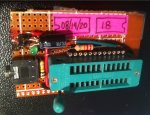IronJungle
Senior Member
Lately I have been programming several PICAXEs for people. It is a pain to insert and remove them from my AXE091 dev board just to program them. Plus, I often have a PICAXE already pushed into the dev board. Removing it with all the surrounding wires is not easy and depending on the state of the project it could be harmful to the poor PICAXE I'm trying to program.
Here is a pic of my solution. Per the diagram in the pic, plug the PICAXE in one way into the ZIF socket to program 08, 14, and 20s. To program the 18 the PICAXE notch and pin 1 goto the opposite side of the ZIF socket. It tests fine with all the PICAXEs mentioned. I must say that I did NOT design the project to work with the 20, but it does. I thought the length of the 20 would interfere with the d/l circuit of the (inverted) 18.
Build details at: http://ijprojects.blogspot.com/2012/07/zif-socket-allows-programming-of-picaxe.html
I am going to guess this has been done (I didn't look) but I think it is a handy way to program multiple PICAXEs with one small package.

Here is a pic of my solution. Per the diagram in the pic, plug the PICAXE in one way into the ZIF socket to program 08, 14, and 20s. To program the 18 the PICAXE notch and pin 1 goto the opposite side of the ZIF socket. It tests fine with all the PICAXEs mentioned. I must say that I did NOT design the project to work with the 20, but it does. I thought the length of the 20 would interfere with the d/l circuit of the (inverted) 18.
Build details at: http://ijprojects.blogspot.com/2012/07/zif-socket-allows-programming-of-picaxe.html
I am going to guess this has been done (I didn't look) but I think it is a handy way to program multiple PICAXEs with one small package.

Last edited:
